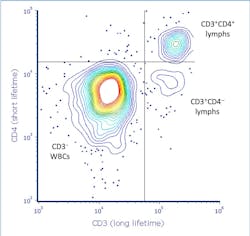Kinetic River receives second grant to further development of compensation-free flow cytometer
Flow cytometry instrumentation developer Kinetic River (Mountain View, CA) has been granted a Phase II Small Business Innovation Research (SBIR) grant from the National Institutes of Health (NIH). The two-year grant was issued to the company by the National Institute of General Medical Sciences (NIGMS), an NIH institute fostering extramural research focused on development of innovative biomedical diagnostic and therapeutic platforms. Following the completion of the Phase I feasibility project (also funded by NIGMS), this grant will support continued design, engineering, and validation efforts toward commercialization of the company's Arno cell analysis technology.
The main goal of the Phase II project is to deliver a compensation-free, 14-parameter flow cytometer for use in biomedical research and in pharmaceutical research and discovery. The approach uses time-resolved fluorescence signatures to add a new dimension of discrimination to cell labeling, enabling a significant reduction in cross-channel spectral contamination. The approach also reduces the number of lasers and detectors needed for a given number of fluorescence detection channels (only two lasers and six detectors needed for 12 fluorescence channels). What's more, the Arno technology uses standard fluorophores and established flow cytometry workflows, and is also compatible with sorting.
Related: Kinetic River receives new Phase I SBIR grant for flow cytometry technology
"...With NIGMS's approval to move forward into Phase II, we have now embarked on a longer arc of planning and development aimed at reducing all remaining technical risks and putting us on the path to product launch," says Giacomo Vacca, Ph.D., president of Kinetic River.
The compensation-free 14-parameter analyzer under development ("No-Comp"), aimed at the broadest segment of flow cytometry users, will be the first of several products planned for the Arno technology platform. The company anticipates expanding the Arno platform by following this with a highly multiplexed flow cytometer ("Hi-Mux"). The Hi-Mux offering, aimed at immunophenotyping applications, will provide users with 25+ detection parameters while employing only three lasers and 14 detectors.
For more information, please visit kineticriver.com.
